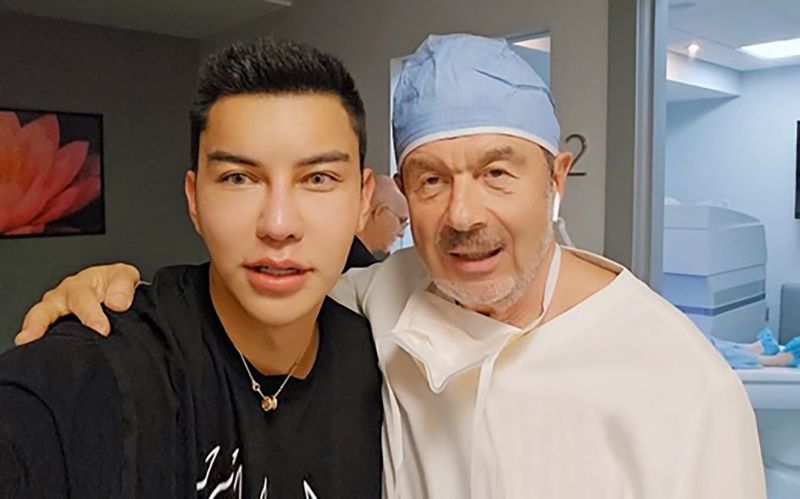When he was a kid watching American movies in Thailand, Jack Titus’ one dream was to become an American. After the model made it a reality a few years ago with a move to Las Vegas, he developed a new dream: To look more like an American. And to him, that meant eyes that weren’t dark like his.
Colored contacts were OK, but when he started researching other options, he found a type of surgery that could lighten his eyes permanently.
Three years ago, when the now-32-year-old told his family he was having the procedure, they were shocked. “They tell me it’s too risky, because you only have one set of eyes,” Titus said.
Colored contacts, which cover the colored part of the eye with a tinted lens, have been used for cosmetic reasons since the 1940s – there’s even speculation that myopic Marilyn Monroe may have worn them – but cosmetic surgery to make a color change permanent is a more recent phenomenon. The trend has been popular in parts of Europe for about a decade but really started taking off in the United States over the past few years after people revealed their dramatic color transformations on social media apps like TikTok and Instagram.
Procedures called iris implants have received US Food and Drug Administration approval for people who are missing part or all of their iris, but no procedure is approved for cosmetic purposes. In January, the American Academy of Ophthalmology issued a warning about the risks of vision loss and complications with two eye color change procedures: iris implants and the one Titus had, called keratopigmentation.
But when Titus looks in the mirror and sees that his once-dark eyes are now blue-gray, he says, he’s grateful that he had the surgery.
“I love the result. Every day when I wake up, it’s much more easy for me,” he said.
A person’s eye color comes from the iris, the colored ring that shines through the clear cornea. With keratopigmentation, a surgeon will use a needle or laser to make space in the cornea and then injects pigment into the cornea to hide the original color of the iris. The procedure is not reversible, but the color can be tweaked if a patient decides they want a different shade. Some doctors say the color may fade over time and a touch-up may be needed.
Titus’ doctor, Dr. Alexander Movshovich, developed a surgical instrument that creates a tiny channel in the cornea for that injection.
The process is kind of like a tattoo for the eye, but instead of the artist making several channels in the skin to insert pigment, this procedure requires only one or two tiny openings.
Also, pigment can leak out with a tattoo but not with this procedure, Movshovich said, since he closes the channels.
“It’s in a secluded space,” he said.
The process can cost about $12,000, and because it’s a cosmetic one, it is not covered by insurance.
‘Basically art’
Movshovich, whose office in New York also offers typical ophthalmological procedures like LASIK, cataract surgeries and retinal repairs, says he has done nearly 1,000 eye color change surgeries but admits that he initially had doubts about their safety.
About a decade ago, when a friend from France told him about the surgical approach, he didn’t believe it.
“I said, ‘Bullsh*t, you cannot do it,’ ” Movshovich said.
At the time, the only real options to permanently change eye color required a doctor to implant a prosthetic iris over the original or to use a laser to destroy pigment cells in the iris to lighten its color.
Any surgery carries an infection risk, but these particular procedures can also lead to damage to the cornea and vision loss, according to the American Academy of Ophthalmology.
“Both of those procedures were total no-nos for me,” Movshovich said.
When he learned about about keratopigmentation, he wanted to know more. Movshovich flew to France, where he watched about a week of surgeries, and says the procedure tapped into all his interests.
“I’m a photographer also, and part of this is basically art,” he said.
A change to stand out
In January, when the American Academy of Ophthalmology released its warning against cosmetic eye color change procedures, Dr. Ashley Brissette said, its concerns included dye leakage, allergic reactions to the dye and the potential risk of infection. Other concerns include light sensitivity and damage to the cornea that can lead to cloudiness or vision loss.
“Anything that we do with the eyes, we have to be very, very cautious, and we want people to know all of the information so they can make a decision that’s right for them,” said Brissette, a spokesperson for the organization and assistant professor of ophthalmology at Weill Cornell Medicine and New York Presbyterian Hospital. “Really, it was just to outline the risk of doing these cosmetic procedures.”
One small 2023 study of people who had the procedure in France found that most noticed some pain afterward, in addition to dry eye, glare and a tingling sensation, but most of the symptoms went away within two days. A few people reported pain and tingling for several months after, but most of the patients said they were highly satisfied with the procedure.
Movshovich said he’s as careful with keratopigmentation as he is with any surgery and is particularly mindful about reducing the chances of infection. None of his patients has reported serious problems related to the procedure.
“The possibility of a general infection is tiny because you don’t have the opening to the air, and you do it all under sterile conditions since it’s a surgical procedure,” he said.
He uses a medical-grade material for the pigment that he designs for each patient based on in-depth conversations with them.
The conversations are interesting, he said, because he also learns what motivates people with healthy eyes to choose surgery.
Some tell him they feel like they were born with the wrong color and want to feel more like themselves. A small fraction – about 5% to 10% – say they believe that people with green or blue eyes are more successful in business, more creative or even luckier. Some just want a change for cosmetic reasons and want to stand out.
Statistically, Movshovich said, only about 15% to 18% of the world’s population has blue or green eyes.
‘I look like myself’
Ever since seventh grade, Reva Stout has wanted to change her dark brown eyes to get a different look. The 49-year-old Navy veteran says she tried nearly every color contact she could find, including a striking violet, but she got sick of contacts and started researching other options.
After talking with staffers at Movshovich’s office about safety and effectiveness, Stout, who lives in Atlanta, booked a flight to New York.
“A lot of people thought I was crazy. They were like ‘Oh, my God, why would you do that? You’re going to go blind.’ ” Stout said. “Others panicked way more than I did.”
Sign up here to get The Results Are In with Dr. Sanjay Gupta every Tuesday from the CNN Health team.
The entire process to make her eyes a lighter brown took 27 minutes.
“There was no pain,” Stout said. “I literally felt nothing.”
She took antibiotics to prevent infection and wore sunglasses for a couple of days after the procedure, but then she started to forget about it until she’d walk past a mirror. The same was true when she went back to have the color adjusted so it looks a little more natural. “I’m really happy with this color now.”
Titus says that, other than the trouble of explaining to the driver’s license office that changing your eye color was indeed possible, he’s been happy with his results and hasn’t had any problems.
“Now, with my new color, I just look like myself.”

